
Applied Open Science Talk GSA 2020
- Subject:
- Life Science
- Social Science
- Material Type:
- Lecture Notes
- Author:
- Jennifer Lodi-smith
- Yunhwan Lee
- Date Added:
- 08/03/2021

Applied Open Science Talk GSA 2020
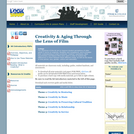
The objectives of this kit are to improve student perceptions of older adults in terms of creativity, flexibility and competence, and to broaden their understanding of what constitutes "creative" expression. Both documentary and feature films were used in order to explore the differences in intent between these different media, as well as the issues of time period, race, gender, culture and nationality.
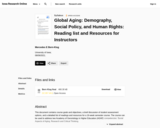
This document contains course goals and objectives, a brief discussion of student assessment options, and a detailed list of readings and resources for a 16-week semester course. The course can be used to address two Academy of Gerontology in Higher Education (AGHE) competencies: Social Aspects of Aging, Research and Critical Thinking.
Versions of this course have been taught to both undergraduate and graduate students in gerontology, public health, global studies, and social work.
The conceptual framework used to select and organize course materials is the United Nations Principles for Older Persons. The first half of the course lays the foundation to understand population aging basics and relies heavily on sections of the Population Reference Bureau's, Population Handbook, as well as United Nations reports. The second half of the course focuses on the UN Principles for Older Persons, with readings related to each principle: Independence, Participation, Care, Dignity, and Self-Fulfillment. Two other UN frameworks introduced in the course are: WHO Active Aging Framework and the UN Sustainable Development Goals.
A main message of the course is that the meaning of "older adulthood" is a product of society. It can and does change over time. Societies can choose to develop programs and policies that affirm the older adulthood stage of life or can stigmatize or ignore the life stage. Each approach has implications for all members of society.
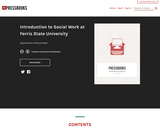
This book was written by MSW students as their final project for their Capstone class. Students were each assigned a chapter of the book to write to show that they had achieved competency as a Master’s level social worker. Chapters were assigned based on student interest and experience in certain areas of the field.
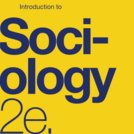
Introduction to Sociology 2e adheres to the scope and sequence of a typical, one-semester introductory sociology course. It offers comprehensive coverage of core concepts, foundational scholars, and emerging theories, which are supported by a wealth of engaging learning materials. The textbook presents detailed section reviews with rich questions, discussions that help students apply their knowledge, and features that draw learners into the discipline in meaningful ways. The second edition retains the book’s conceptual organization, aligning to most courses, and has been significantly updated to reflect the latest research and provide examples most relevant to today’s students. In order to help instructors transition to the revised version, the 2e changes are described within the preface.
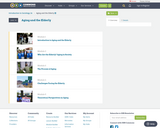
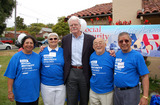
Understand the difference between senior age groups (young-old, middle-old, and old-old)Describe the “graying of the United States” as the population experiences increased life expectanciesExamine aging as a global issue
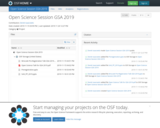
Open Science Session GSA 2019
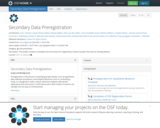
Preregistration is the process of specifying project details, such as hypotheses, data collection procedures, and analytical decisions, prior to conducting a study. It is designed to make a clearer distinction between data-driven, exploratory work and a-priori, confirmatory work. Both modes of research are valuable, but are easy to unintentionally conflate. See the Preregistration Revolution for more background and recommendations.
For research that uses existing datasets, there is an increased risk of analysts being biased by preliminary trends in the dataset. However, that risk can be balanced by proper blinding to any summary statistics in the dataset and the use of hold out datasets (where the "training" and "validation" datasets are kept separate from each other). See this page for specific recommendations about "split samples" or "hold out" datasets. Finally, if those procedures are not followed, disclosure of possible biases can inform the researcher and her audience about the proper role any results should have (i.e. the results should be deemed mostly exploratory and ideal for additional confirmation).
This project contains a template for creating your preregistration, designed specifically for research using existing data. In the future, this template will be integrated into the OSF.
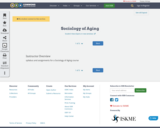
syllabus and assignments for a Sociology of Aging course
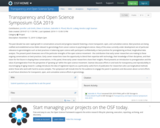
The past decade has seen rapid growth in conversations around and progress towards fostering a more transparent, open, and cumulative science. Best practices are being codified and established across fields relevant to gerontology from cancer science to psychological science. Many of the areas currently under development are of particular relevance to gerontologists such as best practices in balancing open science with participant confidentiality or best practices for preregistering archival, longitudinal data analysis. The present panel showcases one of the particular strengths of the open science movement - the contribution that early career researchers are making to these ongoing conversations on best practices. Early career researchers have the opportunity to blend their expertise with technology, their knowledge of their disciplines, and their vision for the future in shaping these conversations. In this panel, three early career researchers share their insights. Pfund presents an introduction to preregistration and the value of preregistration from the perspective of “growing up” within the open science movement. Seaman discusses efforts in and tools for transparency and reproducibility in neuroimaging of aging research. Ludwig introduces the idea of registered reports as a particularly useful form of publication for researchers who use longitudinal methods and/or those who work with hard-to-access samples. The symposium will include time for the audience to engage the panel in questions and discussion about current efforts in and future directions for transparent, open, and cumulative science efforts in gerontology.